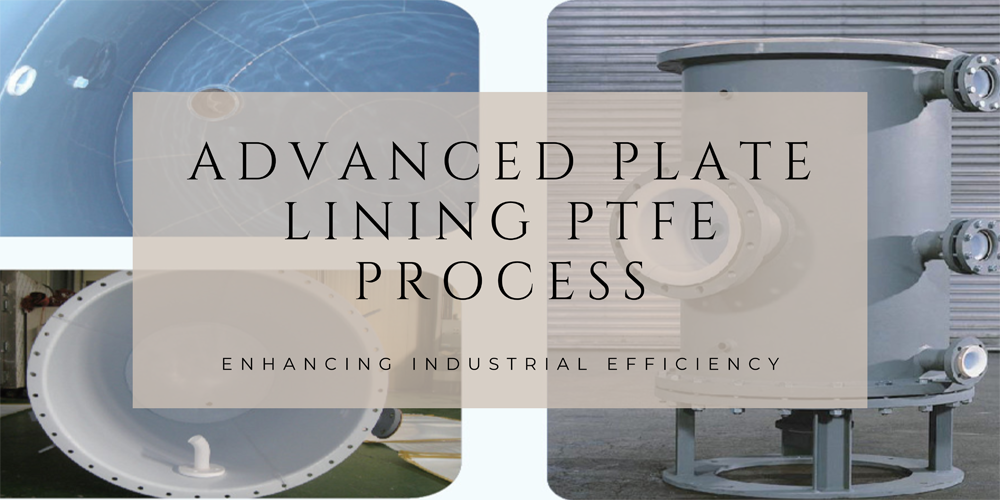
The sheet lining process involves selecting the optimal polytetrafluoroethylene (PTFE) material and thickness according to the different operational requirements of the users. This PTFE material is bonded to the surface of the steel substrate, aiming to protect the equipment from corrosion. The specific steps include initially sandblasting the steel substrate to a Sa2 level and cleaning it with a detergent, followed by the application of an adhesive. A pre-activated (or composite glass fiber) PTFE sheet is also coated with adhesive. The PTFE sheet is then bonded to the steel substrate using our company's unique vacuum lining technology.
The sheet lining process is not limited by the size of the manufacturing equipment and addresses three major challenges in the chemical industry and electronic chemicals industry: cleanliness, temperature, and corrosion resistance. It features good impermeability, a smooth and shiny surface, low friction coefficient, resistance to scaling, and a long lifespan.

After the cut PTFE sheets are bonded onto the steel shell, the "V" shaped joints of the PTFE sheets are welded using our unique PTFE welding technology and imported pure PFA welding rods.

After the welding of the sheets is complete, the fluoropolymer lining surface is cleaned, and inspectors conduct a thorough inspection of the lining surface and welds using stringent standards.

Advanced imported thickness measuring devices are used to perform non-destructive testing on the thickness of the fluoropolymer lining, which must meet the design specifications.

An imported spark tester is used to inspect the fluoropolymer lining at a voltage of 15KV and a speed of ≤100mm/s, as per HG/T4090-2009 standards, ensuring that there are no sparks.
One of the standout features of the plate lining PTFE process is its exceptional impermeability to chemicals. Polyetrafluoroethylene (PTFE), with its non-reactive nature, forms an impermeable barrier that effectively protects equipment from a wide range of chemical substances. This quality is crucial in industries such as chemical manufacturing, where equipment is frequently exposed to aggressive and corrosive substances.
The surface quality of PTFE-lined equipment is another significant advantage. The material provides a smooth and glossy finish that not only enhances the aesthetic appeal of the equipment but also plays a critical functional role. A smooth surface reduces the likelihood of scaling and build-up of deposits, which can impair equipment efficiency and increase maintenance requirements. This smoothness also ensures that any residues can be easily washed away, maintaining the cleanliness and operational efficiency of the equipment.
PTFE is renowned for its low friction coefficient, which is among the lowest of any material. This property significantly reduces wear and tear on the equipment, as the friction between moving parts and the lining is minimal. Consequently, equipment lined with PTFE tends to have a longer operational life and requires less frequent maintenance or replacement, providing substantial cost savings over time.
The durability of PTFE is further enhanced by its ability to withstand extreme temperatures, ranging from -196°C to 260°C. This thermal stability ensures that the PTFE lining remains effective under varying operational conditions, from cryogenic to high-temperature environments, without degrading or losing its protective properties.
The versatility of the plate lining PTFE process is another of its key benefits. The technique can be applied to equipment of any size, which is particularly valuable given the diverse dimensions of machinery and components used across different industries. Whether it's a small valve or a large chemical reactor, the process can be tailored to fit, ensuring all equipment can benefit from the same high level of corrosion resistance and surface quality.
This adaptability makes the PTFE lining process a universally applicable solution for a multitude of sectors, including pharmaceuticals, food processing, petrochemicals, and electronics, where equipment integrity and performance are critical.
PTFE (Polytetrafluoroethylene, commonly known as F4):Temperature resistant from -196°C to 260°C, withstands high positive pressure synchronized with the equipment shell, negative pressure resistance from -0.01Mp to -0.08Mpa. Known as "King of Plastics," PTFE can resist corrosion from all chemical media except molten alkali metals and oxygenated aromatics.
PFA (Perfluoroalkoxy):Temperature resistant from -196°C to 260°C, high positive pressure resistance synchronized with the equipment shell, enhanced adhesion with back-covered glass fiber cloth, combined with the company’s unique anti-negative pressure patent technology, with negative pressure resistance up to -0.09Mp to -0.98Mp.
PVDF (Polyvinylidene fluoride, commonly known as F2):Temperature resistant from -40°C to 110°C, withstands high positive pressure synchronized with the equipment shell, negative pressure resistance from -0.01Mp to -0.06Mp, has a relatively hard hardness, making lining more challenging. PVDF is generally used for fiberglass-reinforced storage tanks, with slightly inferior corrosion resistance compared to PTFE.
ECTFE (Ethylene chlorotrifluoroethylene copolymer):Temperature resistant from -60°C to 120°C, withstands high positive pressure synchronized with the equipment shell, negative pressure resistance from -0.01Mp to -0.08Mp. Since it contains less fluorine, its corrosion resistance is slightly inferior to that of PTFE.
| Material | Full Name | Temperature Resistance | Pressure Resistance | Specific Applications |
| PTFE | Polyetrafluoroethylene | -196°C to 260°C | -0.01Mp to -0.08Mp | Chemical processing, pharmaceuticals, food industry |
| PFA | Perfluoroalkoxy | -196°C to 260°C | -0.09Mp to -0.98Mp | Semiconductor manufacturing, harsh chemical environments |
| PVDF | Polyvinylidene fluoride | -40°C to 110°C | -0.01Mp to -0.06Mp | Water treatment, chemical storage tanks |
| ECTFE | Ethylene chlorotrifluoroethylene | -60°C to 120°C | -0.01Mp to -0.08Mp | Chemical handling, pulp and paper industries |
PTFE and PFA imported sheets are produced by renowned European fluoroplastic companies using advanced extrusion processes, typically 3mm thick. These sheets are smooth, uniform, dense, and consistently thick, with a width of 1.2 meters and a length of up to 25 meters. Compared to traditional block-type sheets, this can reduce multiple welds.
The plate lining PTFE process offers unmatched benefits in terms of chemical resistance, durability, and versatility, making it a superior choice for industries looking to enhance the longevity and efficiency of their equipment. With its ability to provide a durable, low-maintenance, and aesthetically pleasing finish, it addresses both practical and economic needs of modern industrial operations.
Feel free to leave your message on our board. If you're looking to inquire about prices or place an order, this is the right place! Let us know the details of your needs, and our team will get back to you with a personalized quote as quickly as possible. We're here to ensure your experience is seamless and satisfactory. Share your requirements or ask any questions you might have - we're eager to assist and look forward to doing business with you!
Name:Tim
Phone:+86-15716151880
Email:[email protected]
Company:BEANT
Address:No. 28, Luoshen Road, Luoshe Town, Huishan District, Wuxi City, Jiangsu Province
